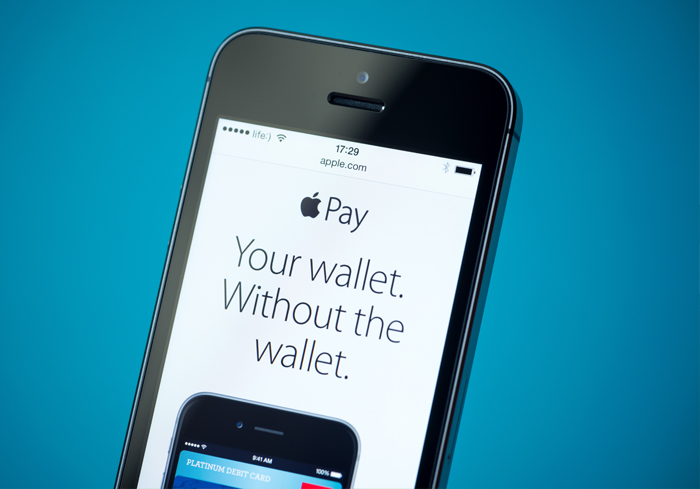
Apple made its grand yet disruptive entrance into the payments ecosystem just 30 days ago. Since then, it’s stirred up a ton of conversations about the widespread adoption of mobile wallets, NFC’s revival, mobile fraud prevention tactics, Apple Pay’s consumer/merchant value proposition, and much more. To compare perspectives and predictions about where Apple Pay has brought us and what’s next, we asked 13 executives from across the industry to tell us what they think, and why. Do their views of Apple Pay reflect yours?

Aurus’ Chief Strategy Officer, Robert Wesley
“Apple Pay has become a major discussion point at Aurus’s Retail and POS Software Developer meetings. They are reporting consumer demand to accept Apple Pay seems too high at Retailer’s marketing to the affluent and/or millennial consumers. Retailers that have experienced security breaches in the past 12 months are also experiencing strong consumer demand to accept Apple Pay. Retailers, who have made an investment in their mobile Apps, have expressed concern that the Apple Pay wallet is in conflict with their mobile marketing strategy. These Retailers are interested in integrating the Apple Pay payment feature into their existing mobile APP to create a more seamless and secure experience. Aurus believes Apple’s solution today is an early step in the evolution of a device enabled mobile wallet.”

Bell ID’s Global Head of Sales, Martin Cox
“The most welcome announcement is the fact that Apple has finally embraced NFC technology. This means that banks finally have clarity and can focus on this preferred communication method of choice at the payment terminal. For Apple’s primary market, the U.S., it’s also strong endorsement for the ubiquity of EMV.”

Brighterion’s Director of Operations and Strategy,Thomas Rand-Nash, PhD
“Other mobile payment solutions have been around for a long time and have received very little adoption. Even if Apple Pay was adopted by every single Apple user as their one and only form of payment, this would still only represent less than 15% of all smart phone users (which itself is only a fraction of all people who use credit cards).
Additionally, making payments is only half the equation. Taking payments is the other half, and, from a micromerchant perspective, Apple Pay introduces a lot more expense than, for example, the $29 Square EMV enabled mobile device accessory for swiping physical EMV cards.
From this perspective, it would seem that Apple Pay, although an interesting technology, and certainly bound to influence perception about mobile payments, is not alone enough to cause a paradigm shift in payments.”

CA Technologies’ VP Product Management, Digital Payments, Doc Vaidhyanathan
“Since the introduction of Apple Pay, the conversation has become a lot more focused. Apple Pay confirmed NFC’s position for the communication between mobile devices and points of interaction (POI). Apple Pay also confirmed the role of existing players in the card space – American Express, MasterCard, Visa and the card issuers. By including the card brands and the vast majority of card issuers in the announcement, Apple Pay clearly declared itself as the default approach supported by issuers. By taking itself out of the transaction flow, Apple is offering higher cardholder privacy and challenging other solutions where an entity other than the card brand or issuer can see all the transactions.
Credit cards have always adhered to the three domain model – card issuers know the cardholder’s financial profile but don’t know what is in the shopping cart, merchants know what is in the shopping cart, but not the card balance or other account details, and the card brands facilitate merchant to issuer interaction without knowing details of the shopping cart or the cardholders financial profile.
What Apple Pay did not do is to address the value of this solution to the merchants – there is no interchange benefit to merchants. Also, the first version of Apple Pay does not offer any value to cardholder or merchants in terms of supporting loyalty programs or couponing capabilities. Apple Pay’s first version is a secure, easy-to-use cardholder experience for those willing to buy the latest iPhones.”

Creditcall’s Chief Technology Officer, Jeremy Gumbley
“Apple Pay has certainly brought the topic of mobile initiated payments to the forefront of the industry once again, but has it brought the topic to the forefront of the mind of consumers? With the news that 1% of transactions performed at Whole Foods are via Apple Pay, we are certainly seeing some early adoption with a retailer that is demographically friendly to Apple’s customer base. Over time, we will learn based upon consumer adoption, if Apple Pay will serve to convince consumers that they need to change their existing behavior by adopting mobile initiated payments.
If Apple can convince consumers that switching to Apple Pay will “solve a problem”, then we’ll see widespread adoption. But, if Apple cannot pull this off with their monster marketing machine and such widespread brand recognition, then I am not sure who can.”

CyberSource’s Senior Vice President, Andre Machicao
“CyberSource is excited to be among the first payment providers to support in-app purchases with Apple Pay. Apple Pay has the potential to accelerate the pace of both mobile commerce and mobile payments adoption in the marketplace. Merchant response to Apple Pay has been very encouraging. We have some early adopters who see Apple Pay as fundamental to their brand experience and we are happy to make that happen. For some merchants, the security aspect of Apple Pay has been a key driver.
CyberSource enables a broad range of payment methods and makes it possible for merchants to accept some of the most popular digital payment solutions online, via mobile and even call centers…all via one connection, on a single platform.”

Ingenico Group North America’s President, Thierry Denis
“Apple Pay sparked the interest of retailers, ISOs, acquirers and banks, and has elevated the NFC and EMV conversation. NFC technology has been around for a while, but no one quite knew when it was going to take off.
With Apple Pay, it’s definitely happening. Almost every conversation we’re having today, since that announcement, includes understanding our offer on NFC and NFC-enabled terminals. Ingenico Group has been a long-time driver and supporter of innovation in the payment ecosystem and we are excited to support merchants as they look to incorporate a seamless payment solution.”

Mahindra Comviva’s Senior VP & Head of Mobile Financial Solutions,Srinivas Nidugondi
“The launch of Apple Pay has created a stir within the industry. Whether it is the conflict of interest with MCX or its business model, everyone seems to be watching its progress with great interest.
I believe the following are the most important contributions of Apple Pay to the mobile payments industry and how it will shape the industry:
1. Providing a push to tokenization: The network led tokenization model combined with unique security and storage credentials that only Apple could have provided is a scalable model that can be replicated in multiple markets in considerably shorter time. Use of tokenization for Apple Pay will go on to reinforce the faith in HCE from Android as well.
2. Web payments: While Apple Pay is expanding into other avenues like ticketing, identity and access management, will it be extended to online payments for web checkouts too?
3. The missing context: While the payment is seamless, we don’t see many context aware value added services being launched which is critical for growth in consumer adoption. Opening up payment APIs for third party wallets can help service providers offer their own wallet with contextual commerce wrapped around payments enabled through Apple Pay. This will create a clear value proposition for the consumer and champion the potential of mobile to be a mainstream and primary channel for payments.
4. How these developments would have an effect on the Android platform.
5. Propelling biometric based authentication: Visa and MasterCard have recently announced replacing passwords with authentication factors such as biometrics.
I believe that Apple Pay has pushed mobile payments into the spotlights especially in markets where iPhones hold a majority of the market share and made it unviable to launch mobile wallet with contactless payments since iPhone did not support it. We are eagerly looking forward to the response from Android and hoping to see APIs from Apple for consumption soon.”

MasterCard’s Chief Emerging Payments Officer, Ed McLaughlin
“The first 30 days of Apple Pay has been an exciting time for MasterCard, banks, merchants and most importantly, consumers. MasterCard cardholders have been thrilled making in-store and in-app payments – knowing that every purchase is secure and offers all the same guarantees and benefits they’ve come to expect from using their MasterCard. Apple has a long tradition of introducing breakthrough products with features that really matter to people, and the rapid adoption of Apple Pay demonstrates that it is really resonating with consumers and merchants.”

Seamless, Provider of the Mobile Payment Solution SEQR’s CEO, Peter Fredell
“Apple’s participation in the mobile payment industry places focus on the way we will pay in the future, and brings the benefits of mobile payment services to the attention of the consumer.
What Apple has going for it is that they waited until the EMV deadline when merchants were going to have to make the hardware investment in payment terminals anyway – giving themselves a leg up on Google and Softcard. However, Apple’s new service is based on traditional card payments, and will therefore not make any fundamental changes to the industry and despite its brand being a strong force it still needs, and fails, to answer the question on value added for the consumer and merchant.
Our view on what’s needed to make it is:
1. There must be a clear incentive for merchants.
2. The system has to be platform-independent.
3. It has to be rewarding for the consumer to pay with your mobile.
The conclusion one month after the launch of Apple Pay is that the conversation is the same “What will it take to get consumers and merchants to leverage mobile payments”, Apple is just one more player in the conversation.”

ThreatMetrix’s Chief Product Officer, Alisdair Faulkner
“Apple’s marketing and brand power has raised the tide for consumer interest in contactless payments which will benefit the ecosystem in general. While the current wave of interest has been in-store purchases, the more interesting component may actually be when TouchID is used for online ‘card-not-present transactions’ which could have significant iThanksmpact on liability shifts from merchants back to banks as well as interchange rates.

TSYS’ Director of Innovation, Katherine McClure
“It took a lot of cooperation from various players in the payments ecosystem to make Apple Pay happen, including TSYS for our issuers, merchants, developers, and Acquirer/ISOs. This is what I see as one of the biggest achievements of Apple Pay – it got groups that haven’t always worked together to do so with a singular goal in mind. That is encouraging for payments but also for the consumer. As we work together to increase merchant and consumer adoption of all mobile payments, electronic payments as a whole wins. Innovation in our industry wins as we build strategic plans to not only move more payments away from analog methods but to build multi-channel, omnichannel, and seamless commerce experiences for consumers.”

VeriFone’s SVP & GM of Vertical Solutions, Joe Mach
“The launch of Apple Pay has created renewed enthusiasm over NFC and mobile payments at the point of sale among merchants, consumers and those following the payments space. The inclusion of NFC in the iPhone 6 and Apple Watch is a big step forward for the use of smart devices in commerce. The ability of a powerful computer like the iPhone 6 to interact with millions of powerful terminals VeriFone has around the world opens up the potential for a whole new shopping experience and interaction between merchants and consumers. What’s most exciting is that we are in the very early days of Apple Pay, and the implications for mobility in commerce remain to be seen.”
For additional insight on Apple Pay’s one-month anniversary, read the PYMNTS commentary: “Apple Pay: One Month In” and learn about the major events that have occurred since the launch.